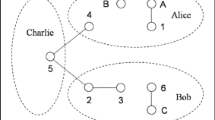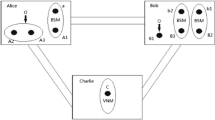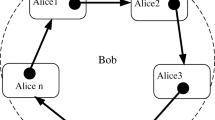Abstract
We present a scheme for bidirectional controlled teleportation by using a six-qubit cluster state as quantum channel. Based on the C-not operation and single qubit measurements, Alice may transmit an arbitrary single qubit state of qubit A to Bob and Bob may transmit an arbitrary single qubit state of qubit B to Alice via the control of the supervisor Charlie.
Similar content being viewed by others
Explore related subjects
Discover the latest articles, news and stories from top researchers in related subjects.Avoid common mistakes on your manuscript.
1 Introduction
Quantum entanglement is the fascinating aspect of quantum mechanics, which has been exploited as a resource to perform different types of quantum tasks such as quantum teleportation [1], quantum dense coding [2], quantum information splitting [3–5], geometric quantum computation [6–8] etc. Quantum teleportation of an arbitrary single qubit, by using an entangled channel of Einstein-Podolsky-Rosen (EPR) pair between the sender and receiver, was first demonstrated by Bennett et al. [9]. It has been under the extensive investigations, many protocols have been devised for the teleportation via different types of multipartite entangled as the quantum channel [10–17]. The first controlled teleportation of an arbitrary single qubit was proposed by using a three-qubit Greenberger-Horne-Zeilinger (GHZ) state [18]. Recently, a number of multipartite entangled states like the GHZ state [19, 20], W state [21, 22], and cluster state [23, 24] have been exploited for carrying out several quantum controlled teleportation tasks [25–27]. In 2012, Zha et al. [28] and Li et al. [29] have reported tripartite schemes for bidirectional controlled teleportation by using five-qubit entangled states as the quantum channel.
In this work, we present a protocol for implementing bidirectional controlled teleportation of an arbitrary single qubit by using a six-qubit cluster state as quantum channel. Suppose that Alice has qubit A in an unknown state, she wants to transmit an arbitrary single qubit state of qubit A to Bob; at the same time, Bob has a qubit B in an unknown state, he wants to transmit the state of qubit B to Alice. The bidirectional controlled teleportation task is completed following the typical procedure that, the receiver applies an appropriate unitary transformation to his qubit, after receiving the measurement results of both the sender Alice (Bob) and the controller Charlie on their separate qubits.
2 Bidirectional Quantum Controlled Teleportation
Our scheme can be described as follows. Suppose Alice has an arbitrary single qubit state, which is given by
and that Bob has qubit B in an unknown state,
Now Alice wants to transmit the state of qubit A to Bob and Bob wants to transmit the state of qubit B to Alice. Assume that Alice, Bob and Charlie share a six-qubit cluster state, which has the form
where the qubits 1 and 4 belong to Alice, qubits 3 and 5 belong to Charlie and qubits 2 and 6 belong to Bob, respectively. The initial state of the total system can be expressed as
To achieve the purpose of bidirectional controlled teleportation task, Alice firstly make a C-not operation with the qubit A as the control qubit and the qubits 1 as the target, on the other hand, Bob make a C-not operation with the qubit B as the control qubit and the qubits 6 as the target. Which will transform Eq. (4) to the result
Then Alice and Bob carry out a single qubit measurement in the basis of {|0〉,|1〉} on qubits 1 and 6, respectively. Subsequently, Alice and Bob perform a single qubit measurement in the basis of \(\{ \vert \pm \rangle= ( \vert 0 \rangle\pm \vert 1 \rangle ) / \sqrt {2} \}\) on qubits A and B, respectively. It is known that Alice and Bob may obtain one of the 16 kinds of possible measured results with equal probability, and the remaining qubits may collapse into one of the 16 states after their measurements. The outcome of the measurement performed by Alice and Bob, and the corresponding collapse state of qubits 2, 3, 4, 5 are shown in Table 1.
Then Alice (Bob) tells the result to Bob (Alice) and Charlie. Whether it is possible for Bob and Alice to reconstruct the original state with local operations to the state is dependent on the controller Charlie. If Charlie allows Bob and Alice to reconstruct the initial unknown state, he needs to carry out the single qubit measurement in the basis of \(\{ \vert \pm \rangle= ( \vert 0 \rangle\pm \vert 1 \rangle ) / \sqrt {2} \}\) on qubits 3, 4 and tells the receivers his result. By combining information from Alice, Bob and Charlie, Alice and Bob can co-operate and make a quantum controlled phase gate (QCPG) operation to reconstruct the original state with an appropriate unitary transformation on the qubit at hand, the bidirectional quantum controlled teleportation is easily realized.
Now, let us take an example to demonstrate the principle of this bidirectional controlled teleportation protocol. Suppose Alice’s single qubit measurement outcome is |0〉1|+〉 A , at the same time, Bob’s single qubit measurement outcome is |0〉6|+〉 B , then the state of the remaining qubits collapse into the state
Then Alice and Bob can co-operate and make a QCPG operation on qubits 2 (set as a target qubit) and 4 (set as a control qubit). The action of this operation may be described as follow equations:
and then the state |Ω〉2345 will become the following state,
Charlie can now make the single qubit measurement in the basis of \(\{ \vert \pm \rangle = ( \vert 0 \rangle\pm \vert 1 \rangle ) / \sqrt{2} \}\) on qubits 3 and 5, and then he sends the result of his measurement to Bob and Alice. If the result of the single qubit measurement is |+〉3|+〉5, |+〉3|−〉5, |−〉3|+〉5 or |−〉3|−〉5, Bob and Alice need to apply the local unitary operation I 2⊗I 4, \(I_{2} \otimes\sigma _{4}^{z}\), \(\sigma_{2}^{z} \otimes I_{4}\) or \(\sigma_{2}^{z} \otimes\sigma_{4}^{z}\). After doing those operations, Bob and Alice can successfully reconstruct the original single qubit state. Thus the bidirectional quantum controlled teleportation is successfully realized.
3 Conclusions
In this paper, we have demonstrated that a six-qubit cluster state can be used as the quantum channel to realize the deterministic bidirectional quantum controlled teleportation of an arbitrary single qubit state. In the scheme, Alice may transmit an arbitrary single qubit state of qubit A to Bob and at same time Bob may transmit an arbitrary single qubit state of qubit B to Alice via the control of the supervisor Charlie. We hope that such a bidirectional quantum controlled teleportation scheme can be realized experimentally in the future.
References
Li, Y.H., Liu, J.C., Nie, Y.Y.: Int. J. Theor. Phys. 49, 2592 (2010)
Li, S.S.: Int. J. Theor. Phys. 51, 724 (2012)
Deng, F.G., Li, X.H., Li, C.Y., Zhou, P., Zhou, H.Y.: Phys. Rev. A 72, 044301 (2005)
Nie, Y.Y., Li, Y.H., Liu, J.C., Sang, M.H.: Quantum Inf. Process. 10, 297 (2011)
Li, Y.H., Nie, Y.Y.: Commun. Theor. Phys. 57, 995 (2012)
Wang, Z.S., Wu, C., Feng, X.-L., Kwek, L.C., Lai, C.H., Oh, C.H., Vedral, V.: Phys. Rev. A 76, 044303 (2007)
Wang, Z.S.: Phys. Rev. A 79, 024304 (2009)
Wang, Z.S., Liu, G.Q., Ji, Y.H.: Phys. Rev. A 79, 054301 (2009)
Bennett, C.H., Brassard, G., Crepeau, C., Jozsa, R., Peres, A., Wooters, W.K.: Phys. Rev. Lett. 70, 1895 (1993)
Li, Y.H., Nie, Y.Y.: Int. J. Theor. Phys. 51, 1806 (2012)
Shi, B.S., Jiang, Y.K., Guo, G.C.: Phys. Lett. A 268, 161 (2000)
Cai, X.H.: Chin. Phys. 12, 1066 (2003)
Muralidharan, S., Panigrahi, P.K.: Phys. Rev. A 77, 032321 (2008)
Rigolin, G.: Phys. Rev. A 71, 032303 (2005)
Yeo, Y., Chua, W.K.: Phys. Rev. Lett. 96, 060502 (2006)
Yan, F.L., Ding, H.W.: Chin. Phys. Lett. 23, 17 (2006)
Li, Y.H., Nie, L.P.: Int. J. Theor. Phys. 52, 961 (2013)
Karlsson, A., Bourennane, M.: Phys. Rev. A 58, 4394 (1998)
Zheng, S.B.: Eur. Phys. J. D 54, 719 (2009)
Nie, Y.Y., Li, Y.H., Wang, Z.S.: Quantum Inf. Process. 12, 437 (2013)
Nie, Y.Y., Li, Y.H., Liu, J.C., Sang, M.H.: Opt. Commun. 284, 1457 (2011)
Li, J.Q., Chen, G., Liang, J.Q.: Phys. Rev. A 77, 014304 (2008)
Li, Y.H., Li, X.L., Nie, Y.Y.: Int. J. Theor. Phys. 52, 84 (2013)
Nie, Y.Y., Li, Y.H., Wang, X.P., Sang, M.H.: Quantum Inf. Process. 12, 1851 (2013)
Nie, Y.Y., Hong, Z.H., Huang, Y.B., Yi, X.J., Li, S.S.: Int. J. Theor. Phys. 48, 1485 (2009)
Yang, C.P., Chu, S.I., Han, S.: Phys. Rev. A 70, 022329 (2004)
Deng, F.G., Li, C.Y., Li, Y.S., Zhou, H.Y., Wang, Y.: Phys. Rev. A 72, 022338 (2005)
Zha, X.W., Zou, Z.C., Qi, J.X., Song, H.Y.: Int. J. Theor. Phys. (2012). doi:10.1007/s10773-012-1208-5
Li, Y.H., Nie, L.P.: Int. J. Theor. Phys. (2013). doi:10.1007/s10773-013-1484-8
Author information
Authors and Affiliations
Corresponding author
Rights and permissions
About this article
Cite this article
Yan, A. Bidirectional Controlled Teleportation via Six-Qubit Cluster State. Int J Theor Phys 52, 3870–3873 (2013). https://doi.org/10.1007/s10773-013-1694-0
Received:
Accepted:
Published:
Issue Date:
DOI: https://doi.org/10.1007/s10773-013-1694-0




